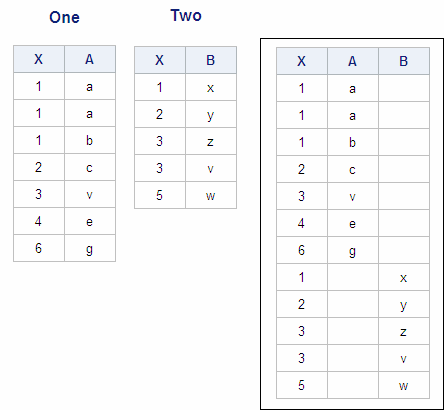Comparing Outer Unions and Other SAS Techniques
A PROC SQL set operation that uses the OUTER UNION
operator is just one SAS technique that you can use to concatenate
tables, as shown in the following programs. Program 1 is the PROC
SQL set operation that was shown earlier in this chapter. Program
2 uses a different SAS technique to concatenate the hypothetical tables
One and Two.
Program 2: DATA Step, SET Statement, and PROC PRINT Step
data three;
set one two;
run;
proc print data=three noobs;
run; These two programs create
the same table as output, as shown below.
When tables have a same-named
column, the PROC SQL outer union does not produce the same output
unless the keyword CORR is also used. CORR causes the same-named columns
(in this example, the two columns named X) to be overlaid; without
CORR, the OUTER UNION operator includes both of the same-named columns
in the result set. The DATA step program generates only one column
X.
The two concatenation
techniques shown above also vary in efficiency. A PROC SQL set operation
generally requires more computer resources but might be more convenient
and flexible than the DATA step equivalent.
..................Content has been hidden....................
You can't read the all page of ebook, please click here login for view all page.

